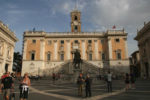| ||||||
CapitoliumThe Capitolium is one of the seven primitive hills of Rome, and one of the most important in history, although it was the smallest of them. Indeed, it was the religious center during antiquity, dominated by the Temple of Jupiter which disappeared long ago. | ||||||
| Copyright © 2025 www.bestofrome.fr : Rome Visit - Tous droits réservés, reproduction même partielle non autorisée - Contact - Cookies, informations et confidentialité | ||||||









Recents comments